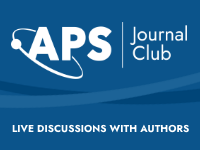| Volume 95, Issue 2 (partial) April - June 2023 | |
Advertisement | Join the APS Division of Laser Science and representatives from the Physical Review Journals at booth #409 during CLEO 2023. Play the Prize Drop game and win an exciting prize! And don't miss our Meet the Physical Review Journal Editors event, to be held Tuesday, May 9, 1:15 p.m. – 1:45 p.m. on the Show Floor Theatre. Discuss your latest submission or learn how to become a referee. | | | | | Advertisement | PRL seeks two Associate Editors to handle all phases of the peer review process and ultimately decide which papers are published. Dynamic and personable individuals with a strong scientific background in either condensed matter and materials science, or physics of fluids, polymer physics, chemical physics, geophysics, or complex systems are encouraged to apply. More information. | | | | | | Not an APS member? Join today to start connecting with a community of more than 50,000 physicists. | | | | Warren E. Pickett Rev. Mod. Phys. 95, 021001 (2023) – Published 7 April 2023  | Superconductivity, discovered in 1911 and first theoretically understood in 1957, remains a fascinating phenomenon for reasons both fundamental and applied. Reliably calculating the critical temperature of a given material, and even more so predicting it, turned out to be a considerable challenge. This Colloquium explains how theoretical developments have led to increasingly reliable predictions that have culminated in the discovery of the hydride materials that display superconductivity under high pressure at temperatures just shy of room temperature. | | | | | | Javier Junquera, Yousra Nahas, Sergei Prokhorenko, Laurent Bellaiche, Jorge Íñiguez, Darrell G. Schlom, Long-Qing Chen, Sayeef Salahuddin, David A. Muller, Lane W. Martin, and R. Ramesh Rev. Mod. Phys. 95, 025001 (2023) – Published 20 April 2023  | Topology provides a framework for an understanding of emergent phenomena in various fields such as the appearance of new results in the field of ferroelectrics. A historical introduction and a primer on the concepts of topology are followed by a discussion of experimental and theoretical methods that elucidate the exotic textures that appear in polar oxide nanostructures and superlattices. The complex interplay of several fundamental processes occurring on different energy scales leads to ground states that compete with one another and have large and/or novel responses with respect to external stimuli. | | | | | | | |

No comments:
Post a Comment